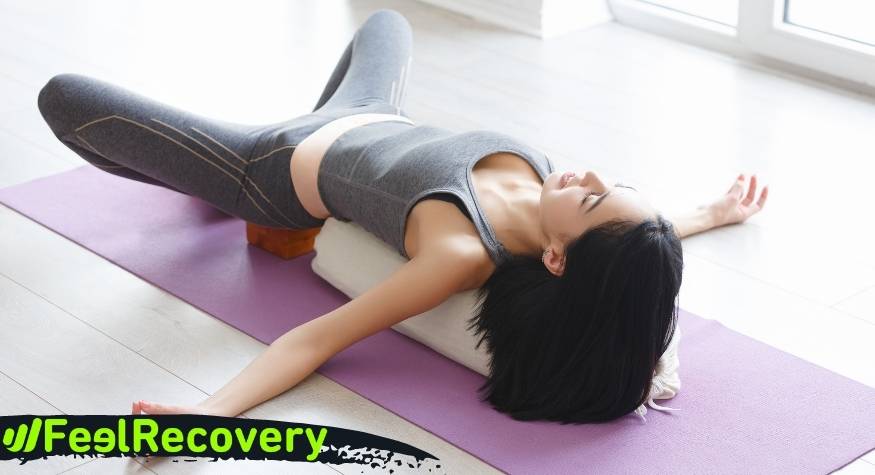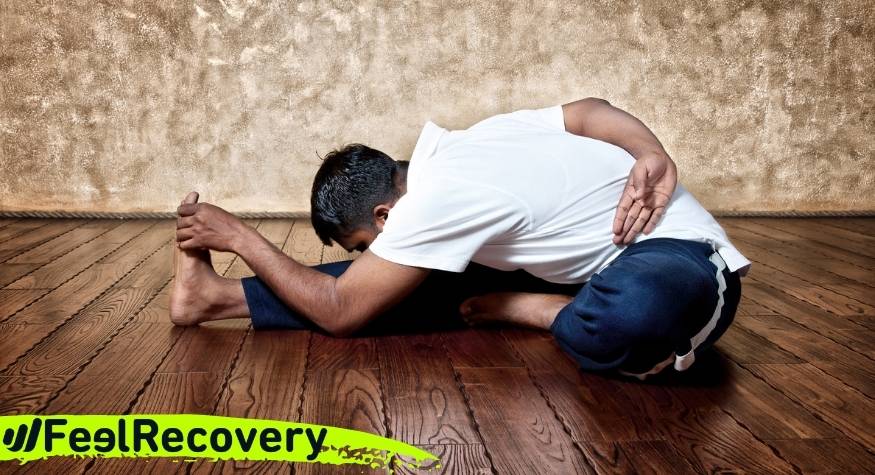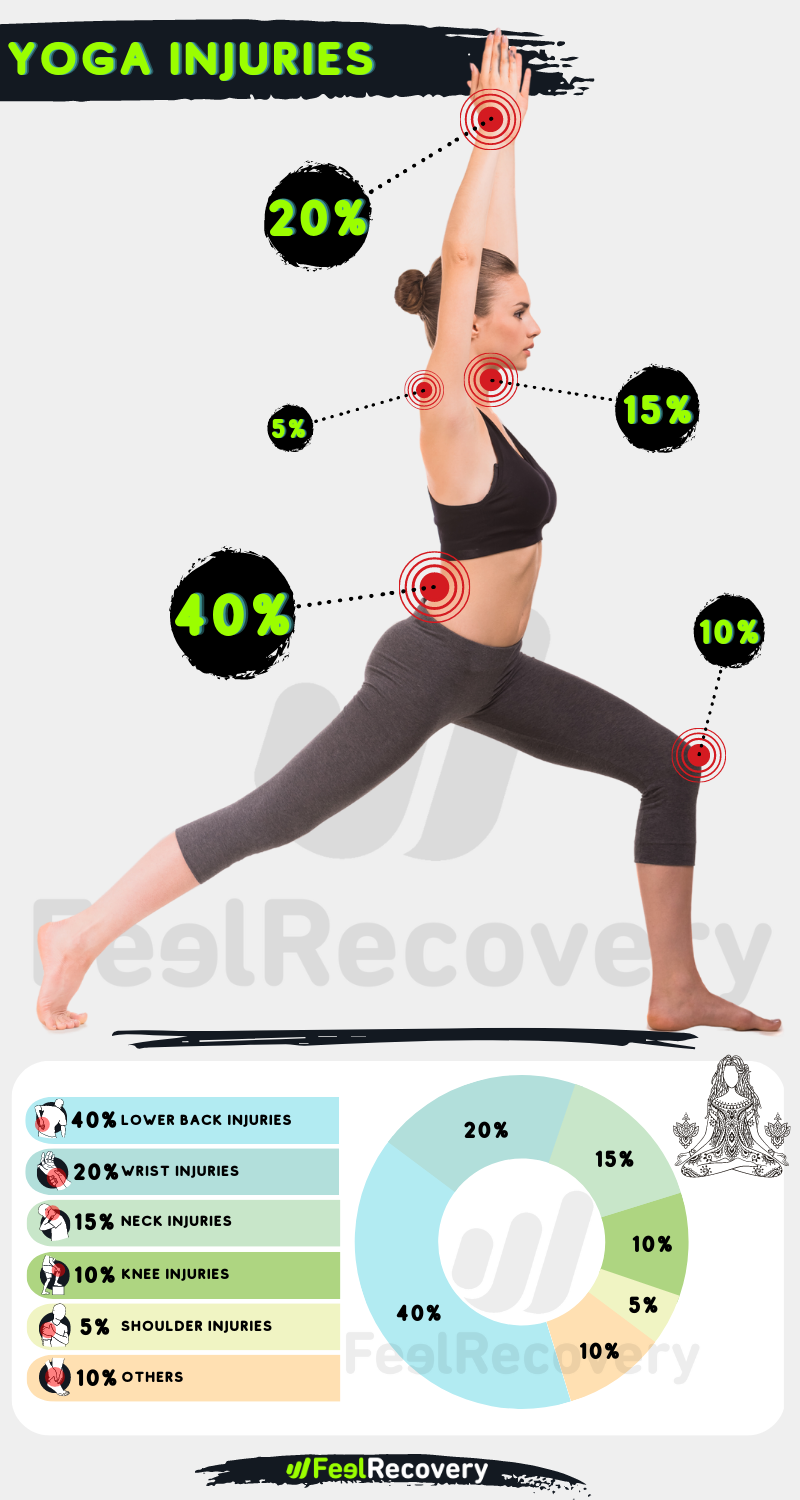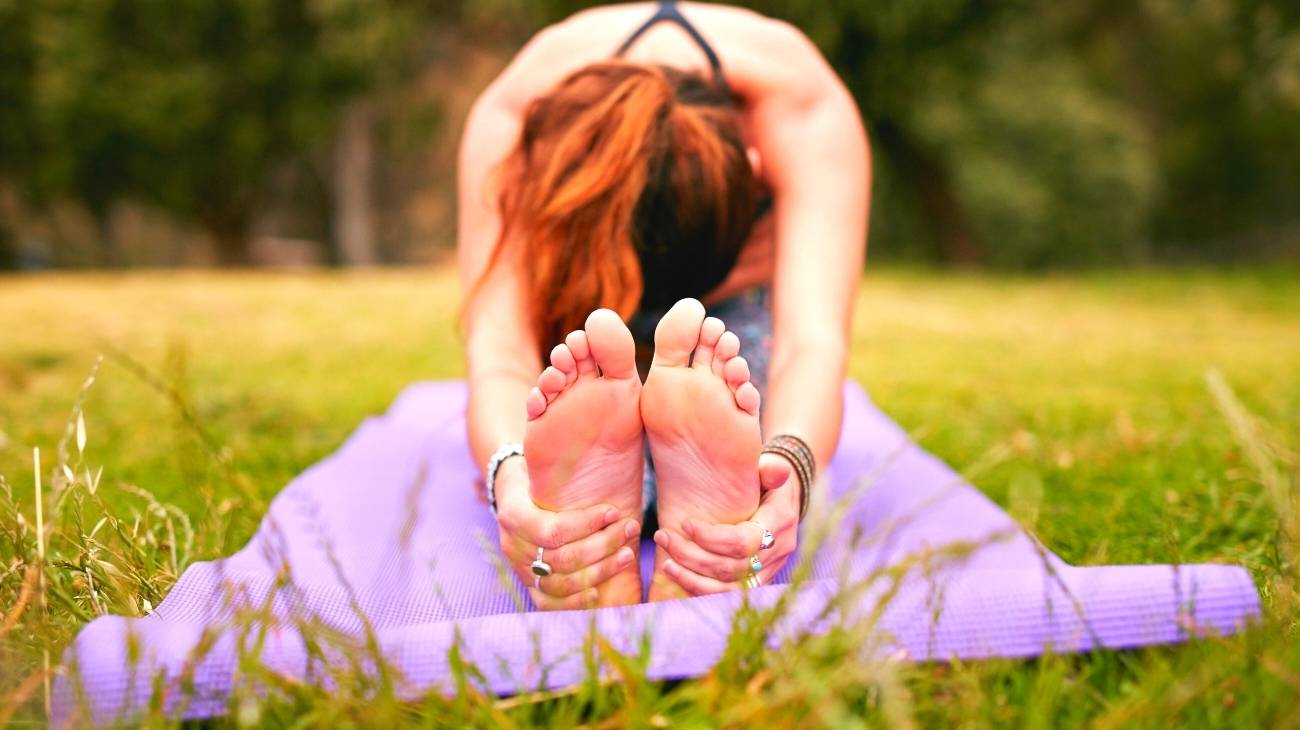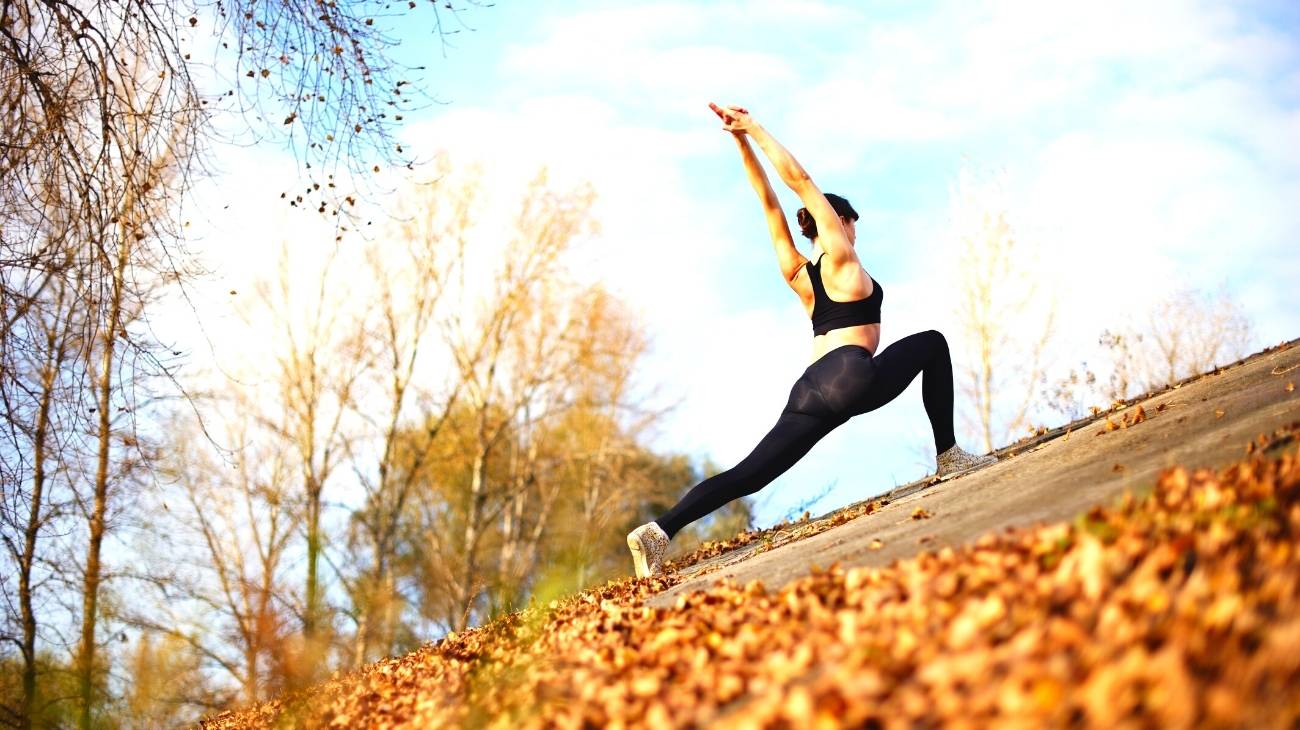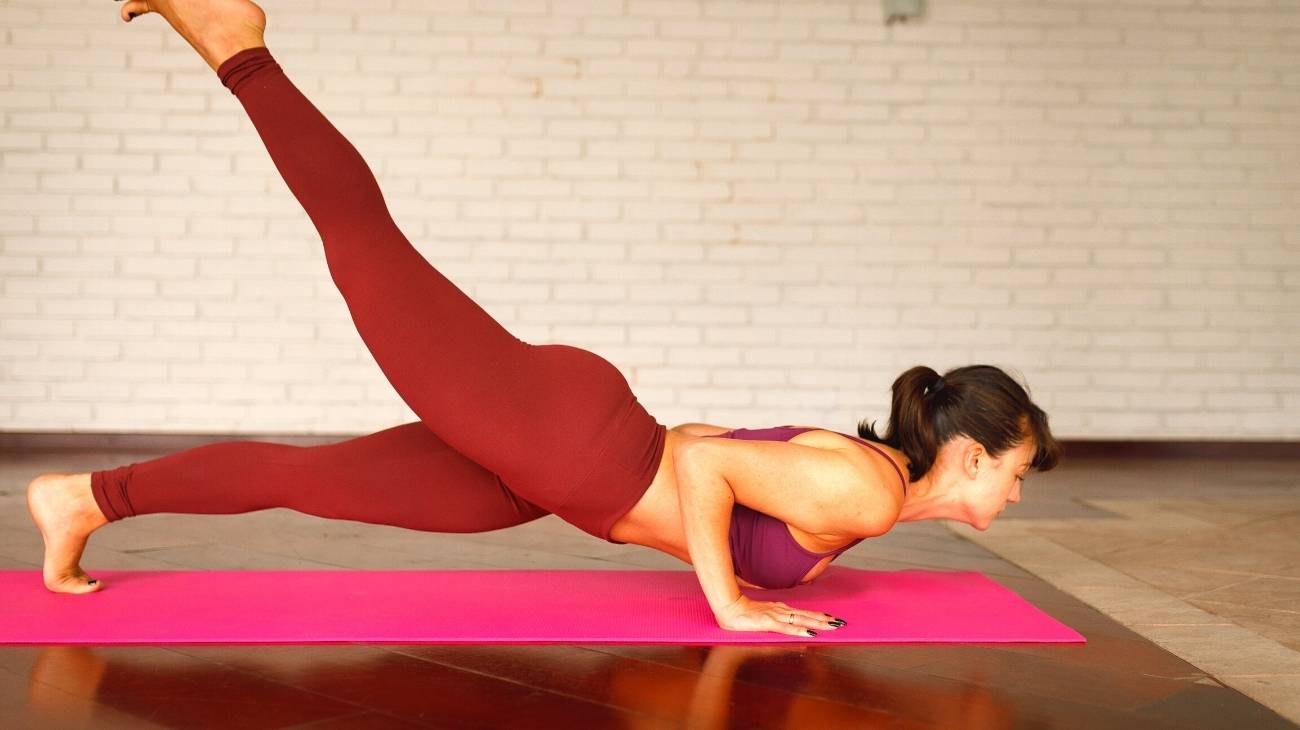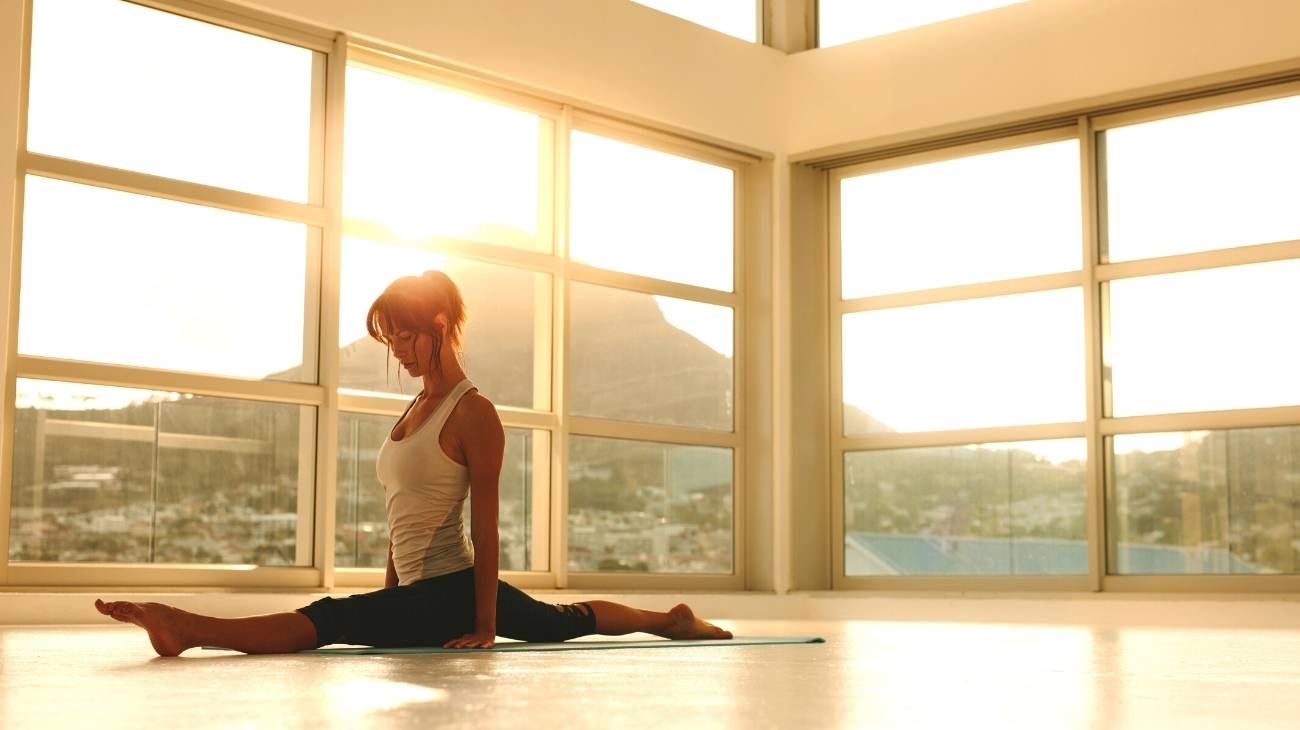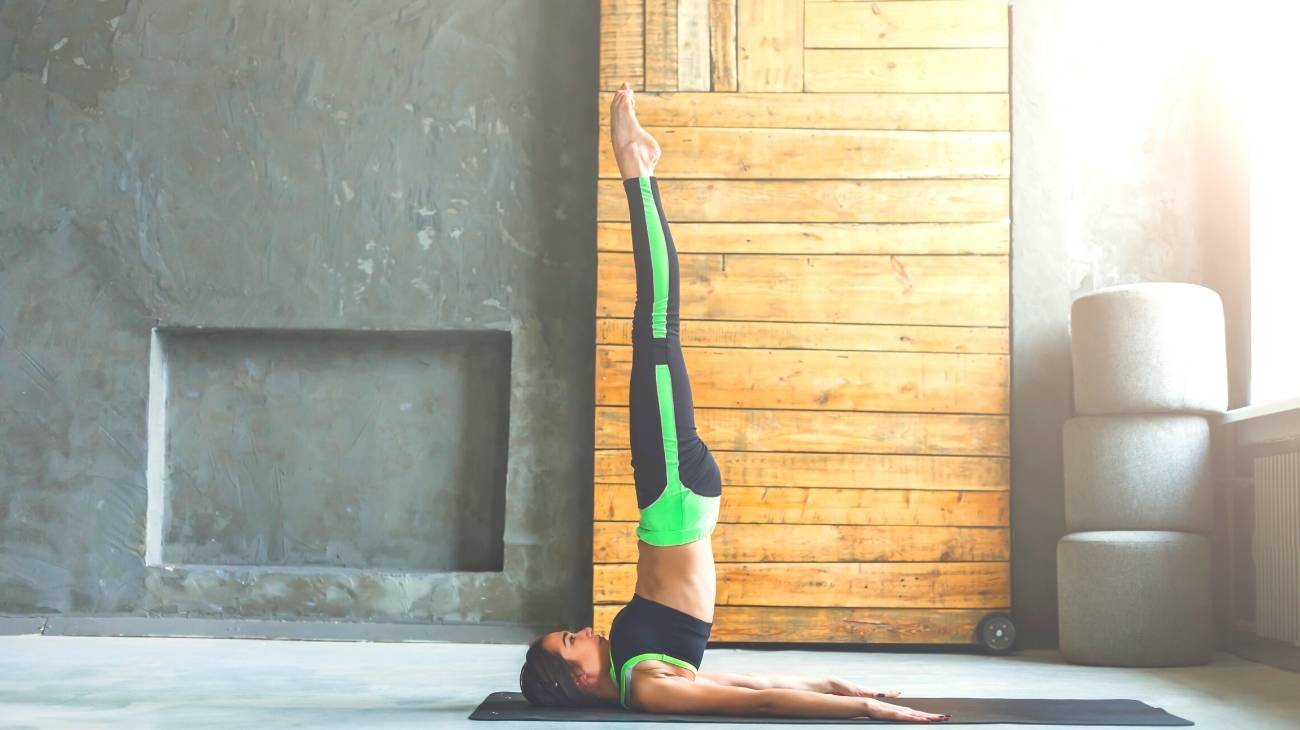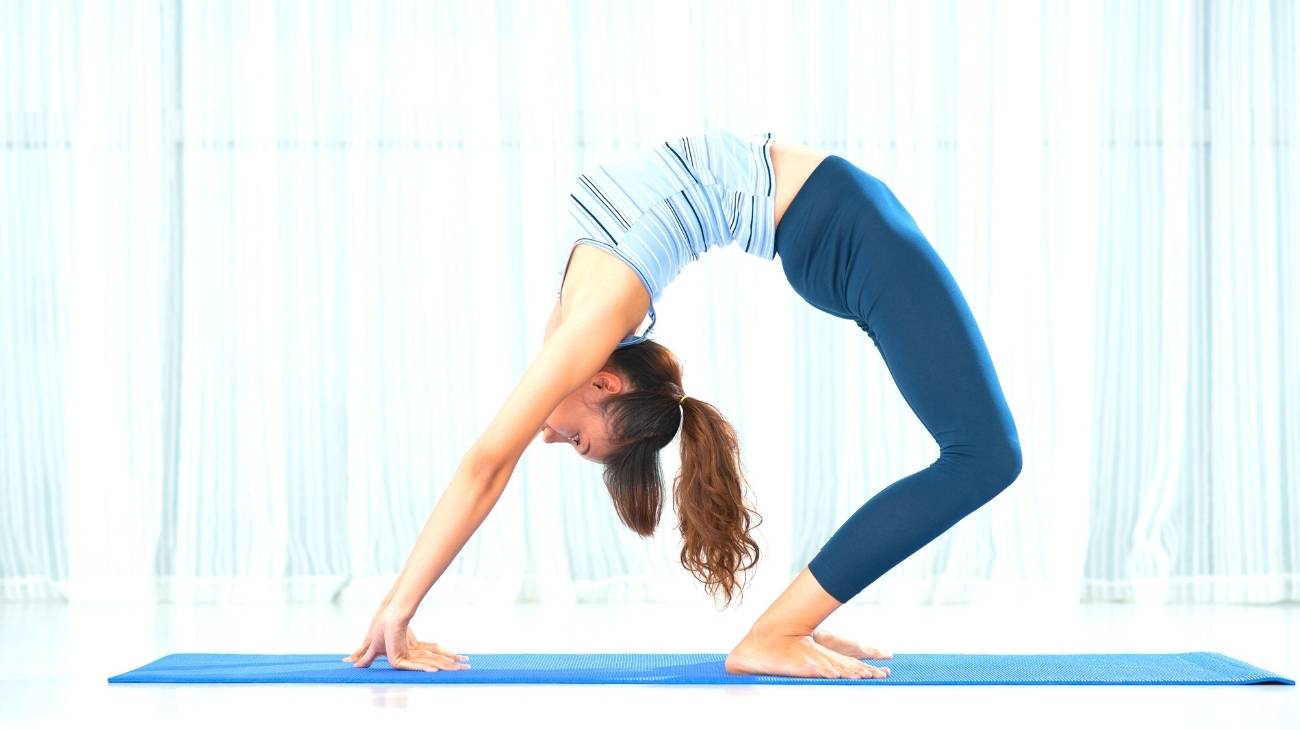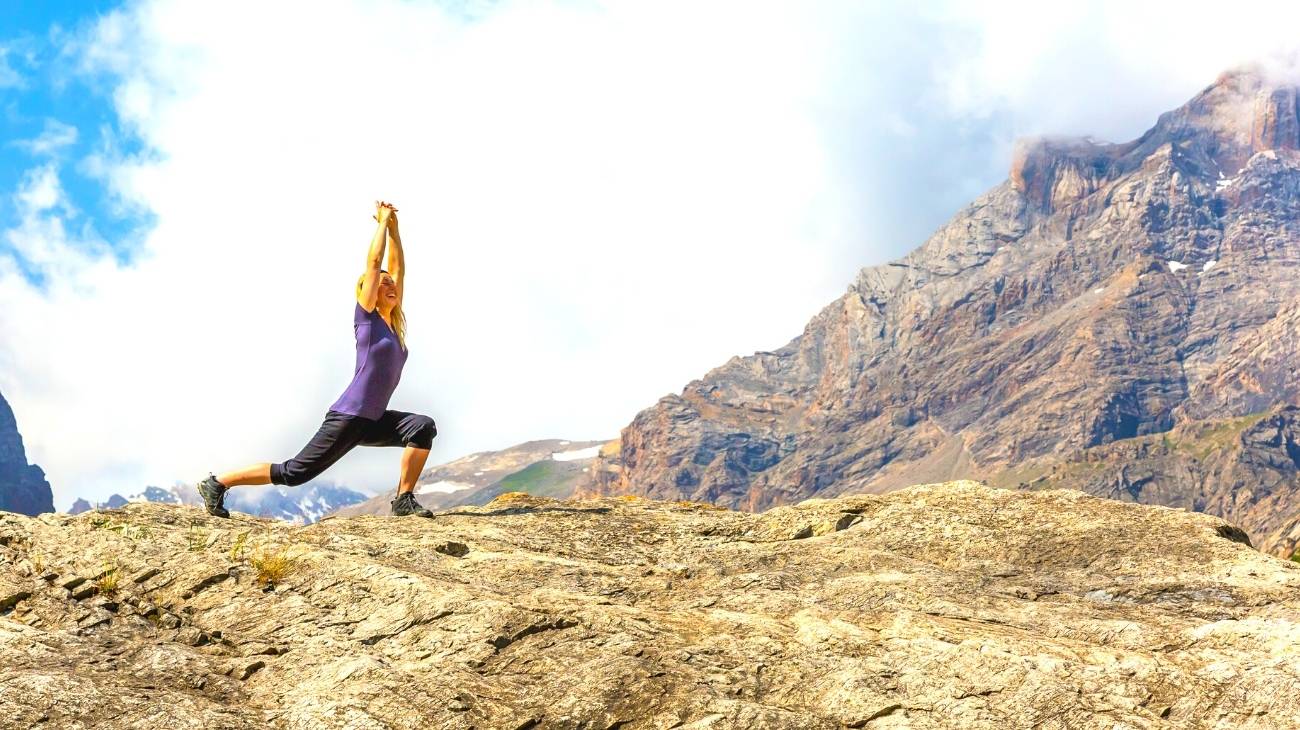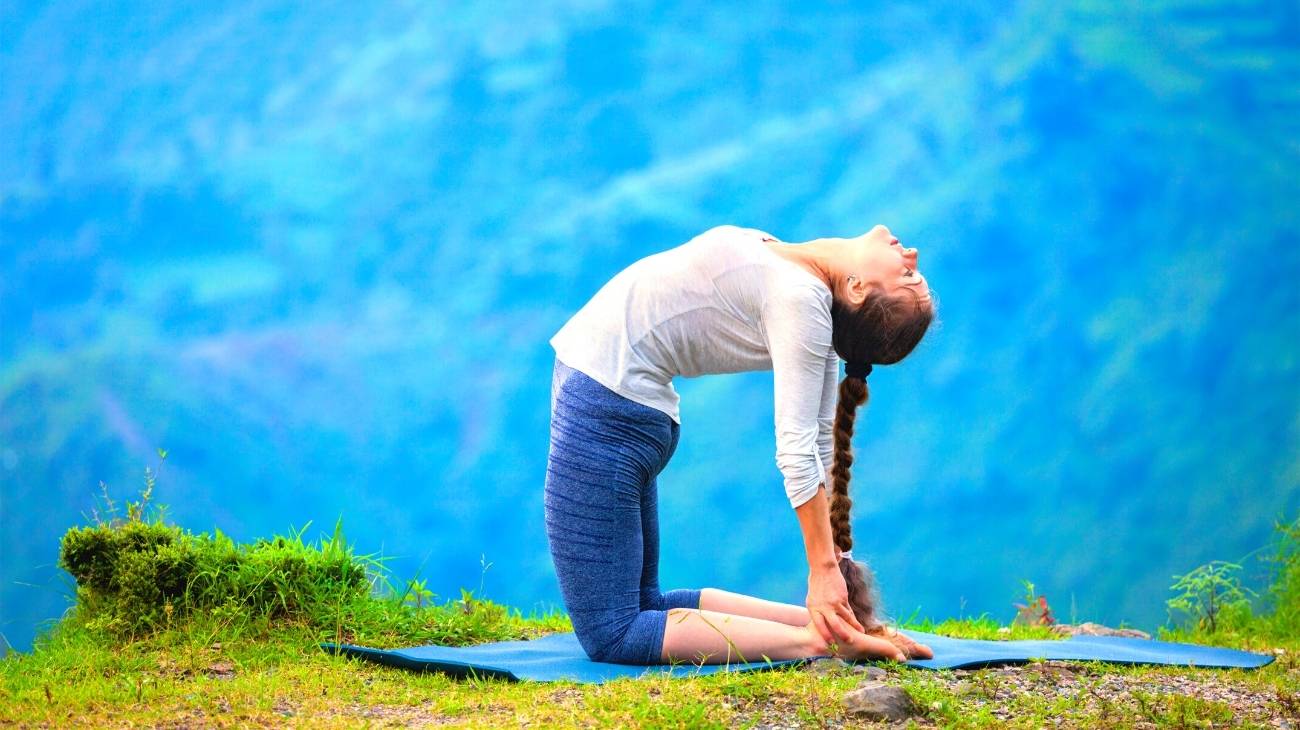Although many highlight the benefits of yoga, the practice of this discipline also carries risks. The asanas or postures performed by yogis are not at all easy and some of them have been linked to various locomotor system disorders. Yes, there are several common yoga injuries and today we are going to tell you about them.
In addition to describing and explaining the causes of these conditions, we will also help you to avoid them through a series of preventive methods. We'll also show you how to treat them using the PRICE recovery protocol. Here we go!
What are the most common types of injuries when doing Yoga?
There are several common yoga injuries in different areas of the body. Knees, lower back, shoulders, waists, legs, necks and other parts of the body can be affected in this discipline when performing an asana incorrectly. The causes of these conditions are varied, some are caused by overuse while others are of traumatic etiology.
The most common yoga injuries are:
Neck injuries
Yogis can also injure their necks. The main postures that put this area at risk are those that involve resting on hands or shoulders. Neck stretches and other asana stretches also stand out as risk factors.
The following conditions are the most prominent:
- Bulging spinal disc: occurs when a disc in the spine becomes deformed and protrudes from the bone without rupturing. It is mainly degenerative in aetiology, although forced movements or activities such as heavy lifting can cause it. They often involve the impingement of a nearby nerve. A bulging disc in the cervical spine can cause mild or severe pain in the neck, shoulders, breasts and arms. It can also numb or weaken the upper limbs.
- Cervical fractures: This is a break in one of the vertebrae of the cervical spine. It can be caused by trauma to the neck such as a fall, sprain or blow. People with osteoporosis and the elderly are at greater risk of suffering this injury. Symptoms include local pain and swelling, as well as weakness, numbness or paralysis in the limbs.
Shoulder injuries
These are among the most common yoga injuries. Many are associated with repetitive stress on the shoulder from frequent asana, although some are of traumatic aetiology. In particular, the chaturanga posture and the way in and out of it can put pressure on this joint and occasionally cause injury.
The following shoulder injuries in yogis are notable:
- Rotator cuff tendonitis: Occurs when the rotator cuff tendons become inflamed. It occurs mainly due to overuse. It primarily causes pain at the tip of the shoulder that can spread and worsen with movements such as pushing, pulling, raising the arm, and so on.
- Rotator cuff tears: Involve partial or complete rupture of the rotator cuff, especially its tendons. It most often affects the supraspinatus tendon. It is caused by trauma (fall on the arm in extension, excessive weight lifting) or wear and tear (continuous use, ageing). The usual symptoms are pain that may worsen with raising and lowering the arm, weakness and crunching.
- Dislocation of the shoulder: Occurs when the humerus pulls out of the glenoid socket of the scapula. A dislocation can be total (dislocation) or partial (subluxation). It is usually caused by a blow, fall, rotation or overstretching of the shoulder. Associated symptoms are deformity, pain, swelling, bruising and possible damage to surrounding tissues.
- Shoulder bursitis: Occurs when one of the bursae of the shoulder becomes inflamed. It manifests mainly as shoulder pain that worsens with abduction or extension of the arm. Possible causes include trauma, overuse, bacterial infection or disease such as arthritis.
- SLAP (superior labrum anterior to posterior) lesions: Occurs when the upper part of the glenoid labrum is partially or completely torn. It causes local pain that is usually intermittent and aggravated by overhead movements. Basically, it can arise from trauma such as a fall or repetitive overhead movements of the shoulder.
Hand and wrist injuries
Yogis are prone to pain in this area, especially in the wrist. These injuries are mainly caused by overloading or overuse of the wrist. This can occur especially when performing certain postures of this discipline inadequately or with little preparation. Arm balances, planks and downward dog are some of the postures that pose the greatest risk to this area.
Hand and wrist injuries that can occur in yoga include:
- Tendonitis of the wrist: In general, tendonitis is the inflammation of a tendon, and yogis may experience it in the wrist. In this joint there are several tendons that may become inflamed, such as the extensor carpi ulnaris (ECU). This condition is mainly caused by overuse, but also by injury. Symptoms include pain, stiffness, tenderness, swelling and crepitus in the area.
- Dorsal impingement syndrome of the wrist: This is an inflammation of the joint capsule of the wrist. It is specifically pinched between the extensor carpi radialis brevis tendon and the scaphoid bone. This injury is caused by repetitive straightening and extension movements of this joint while bearing weight. It is characterised by pain in the dorsum (back) of the wrist, especially when the wrist is bent backwards (fully extended).
- Carpal tunnel syndrome: This is a pinching of the median nerve within the carpal tunnel. Anything that involves narrowing the space inside the carpal tunnel can cause this condition. Risk factors include injury, disease (such as rheumatoid arthritis) and repetitive or forceful manual activities. Symptoms include pain, numbness, tingling and weakness in the hand and forearm.
- Triangular fibrocartilage complex tear: Occurs when the triangular fibrocartilage complex (TFCC) tears. It usually causes pain on the ulnar side of the wrist that may worsen with activity. It can be caused by a fall or other trauma, as well as overuse.
Lower back injuries
Low back pain is common in yogis due to postures that strain the lower back. The aetiology of these injuries includes back movements such as bending (forward or backward) and twisting. Some of the postures frequently related to these conditions are: Paschimottanasana, chakrasana and supta kurmasana.
The most common lower back injuries in yogis are:
- Sacroiliac (SI) joint dysfunction: occurs when the SI joint has certain mechanical irregularities, i.e. it moves improperly. It manifests as pain in the lower back (under the L5 vertebra), buttocks and hips that may radiate down the leg. It can be caused by pregnancy, childbirth or trauma such as falls, weight lifting with twisting, among others.
- Lumbar strain: This occurs when the muscles or tendons in the lower back are overstretched or torn (partially or completely). Forced movements such as severe twisting or stretching can lead to this injury. The main symptoms include: sudden low back pain, spasms, swelling and tenderness.
- Herniated disc: Occurs when the membrane of a vertebral disc ruptures. Natural degeneration is central to the etiology of this injury. It can be caused by heavy lifting or severe back twisting. It can usually result in the impingement of a nearby nerve. If the hernia occurs in the lumbar region it can cause local pain. Pain, numbness and weakness in the lower limbs are also common.
Hip injuries
The hip is another area that can be injured in the practice of yoga. This is mainly due to the stretching or extreme movements of this joint that are frequent in this discipline. Postures such as triangle, lunges, standing forward folds, among others, are related to these injuries.
Yogis may suffer from the following conditions:
- Osteoarthritis of the hip: This is a type of arthritis that occurs when the cartilage in the hip wears down. It is mainly degenerative in aetiology and extreme movements of this joint are risk factors. It manifests itself as a local pain that arises and worsens slowly, although it can also appear suddenly. Other symptoms include pain in the lower extremities, stiffness, crepitus and decreased range of motion.
- Hip labral tear: This is a rupture of the labrum covering the hip socket. Possible causes include trauma, repetitive motion and structural problems. It is common in patients with hip impingement. Symptoms include local pain that may spread to the buttocks and groin, stiffness and crepitus.
Ankle, foot and leg injuries
Yogis can also injure other areas of the lower limbs in addition to the knee. Of particular note are injuries to the hamstrings which are related to certain postures involving forward bending in sitting (paschimottanasana) or standing (uttanasana). The feet and ankles may also be affected.
The main injuries to the lower limbs (not including the knee) in yoga are:
- Hamstring tendonitis: This is a leg injury consisting of inflammation of the hamstring tendon. It consists of inflammation of the hamstring tendon. In the case of yogis, this condition occurs at the tendon insertion of this muscle group at the hamstring bones of the pelvis. It occurs mainly due to overuse. Symptoms are pain, weakness, stiffness and swelling in the back of the thigh near the buttock.
- Hamstring strain: This leg injury involves overstretching or tearing (partial or total) of the muscle and/or tendon fibres of the hamstrings. It involves overstretching or tearing (partial or total) of the muscle and/or tendon fibres of the hamstrings. It usually occurs in yogis, specifically at the junction of these muscles with the pelvis, when they are overstretched or overstretched during a posture. Risk factors include: imbalance of leg strength, incorrect warm-up, previous injury, poor flexibility and poor technique. General symptoms are: sudden mild or severe pain, tenderness, popping sensation, swelling, bruising and weakness in the back of the thigh near the buttock.
- Partial Achilles tendon tear: This is an injury that affects the back of the heel and calf. It consists of a partial tear of the Achilles tendon that connects muscles in the calf to the calcaneus (heel bone). This injury is usually caused by a sudden increase in pressure on the tendon, such as during a jump. Symptoms include: a snapping sensation in the calf and sound during the tear, severe pain and swelling near the heel, and reduced range of motion.
- Ankle sprain: Occurs when the ligaments of the ankle are overstretched and may even tear partially or completely. It is of traumatic aetiology and is generally caused by hyperinversion of the foot, a movement involved in some asanas. It usually manifests with local pain, tenderness and reduced range of motion, although it may also cause swelling and haematoma.
- Fracture of the ankle: This involves the breaking of one of the bones of the ankle. Although less common, it can occur in yoga due to a sudden fall or twisting of the ankle. Pain, swelling, bruising and deformity are the main symptoms.
Best products for Yoga injury recovery
Bestseller
-
2 Ankle Compression Sleeve (Black/Gray)
£17,50 -
2 Ankle Compression Sleeve (Green/Navy)
£17,50 -
2 Ankle Compression Sleeve (Pink/Bordeaux)
£17,50 -
2 Elbow Compression Sleeve (Black/Gray)
£17,50 -
2 Elbow Compression Sleeve (Green/Navy)
£17,50 -
2 Elbow Compression Sleeve (Pink/Bordeaux)
£17,50 -
2 Knee Compression Sleeve (Black/Gray)
£17,50 -
2 Knee Compression Sleeve (Green/Navy)
£17,50 -
2 Knee Compression Sleeve (Pink/Bordeaux)
£17,50 -
Acupressure Mat and Pillow (Black/Gray)
£44,95 -
Acupressure Mat and Pillow (Green/Navy)
£44,95 -
Acupressure Mat and Pillow (Pink/Bordeaux)
£44,95 -
Acupressure Pillow (Black/Gray)
£21,52 -
Acupressure Pillow (Green/Navy)
£21,52 -
Acupressure Pillow (Pink/Bordeaux)
£21,52 -
Foot Massage Roller for Plantar Fasciitis (Black)
£17,50 -
Foot Massage Roller for Plantar Fasciitis (Green)
£17,50 -
Foot Massage Roller for Plantar Fasciitis (Pink)
£17,50 -
Gel Eye Mask for Puffy Eyes (Gold/Black)
£9,95 -
Gel Eye Mask for Puffy Eyes (Orange/Pink)
£9,95 -
Gel Eye Mask for Puffy Eyes (Purple/Turquoise)
£9,95 -
High Density Foam Roller for Muscle (Black/Gray)
£24,95 -
High Density Foam Roller for Muscle (Green/Navy)
£24,95 -
High Density Foam Roller for Muscle (Pink/Bordeaux)
£24,95 -
Ice Massage Roller Ball (Black)
£34,95 -
Ice Massage Roller Ball (Green)
£34,95 -
Ice Massage Roller Ball (Pink)
£34,95 -
Microwave Wheat Bag for Neck & Shoulder Pain Relief (Hearts)
£21,50 -
Microwave Wheat Bag for Neck & Shoulder Pain Relief (Oxford)
£21,50 -
Microwave Wheat Bag for Neck & Shoulder Pain Relief (Sport)
£21,50 -
Microwave Wheat Bag for Neck Pain Relief (Hearts)
£17,50 -
Microwave Wheat Bag for Neck Pain Relief (Oxford)
£17,50 -
Microwave Wheat Bag for Neck Pain Relief (Sport)
£17,50 -
Pack 2 in 1: Foam Roller High + Soft Density (Black/Gray)
£24,95 -
Pack 2 in 1: Foam Roller High + Soft Density (Green/Navy)
£24,95 -
Pack 2 in 1: Foam Roller High + Soft Density (Pink/Bordeaux)
£24,95 -
Sacroiliac Support Belt (Black)
£21,95 -
Sacroiliac Support Belt (Green)
£21,95 -
Sacroiliac Support Belt (Pink)
£21,95 -
Shoulder Support Brace (Black)
£21,95 -
Shoulder Support Brace (Green)
£21,95 -
Shoulder Support Brace (Pink)
£21,95 -
Soft Density Foam Roller for Recovery (Black)
£24,95 -
Soft Density Foam Roller for Recovery (Green)
£24,95 -
Soft Density Foam Roller for Recovery (Pink)
£24,95 -
Trigger Point Massage Stick (Black)
£12,95 -
Trigger Point Massage Stick (Green)
£12,95 -
Trigger Point Massage Stick (Pink)
£12,95 -
Wrist Brace (Black/Gray)
£17,50 -
Wrist Brace (Green/Navy)
£17,50 -
Wrist Brace (Pink/Bordeaux)
£17,50
How to prevent injuries when practising Yoga?
In this segment we will give you some tips to prevent common yoga injuries. While these recommendations do not eliminate the risk of injury entirely, they significantly reduce it. So, if you don't want to end a session with a strain, sprain or other similar condition then pay close attention:
- Warm up properly: It is important that you warm up for 15 minutes before you start your yoga session. This will prepare your muscles, tendons and the rest of your body to perform the physical activity correctly and without injury. Stretching and joint movements are essential at this stage.
- Finish your workouts with a cool down: At the end of the session you should finish with a 15-minute cool down. This will allow your body to gradually return to its initial state of rest, relaxing the locomotor system and thus preventing injuries. Breathing, stretching and relaxation exercises are recommended during this period.
- Good nutrition and hydration: Nutrition is essential if you want your body to perform at its best and not get injured while practising yoga. In general, a balanced diet that includes carbohydrates, proteins, fats, vitamins and minerals in adequate proportions is recommended. It is also important to stay hydrated before, during and after the session by drinking enough water.
- Improve your physical fitness: If you want to perform the asanas without injury, it is important that you are physically conditioned. If you are not flexible and strong enough, you may strain yourself too much and injure yourself during asanas. Therefore, it is important that you do the necessary training to prepare you to practice this discipline properly.
- Sports massage: Sports massages are excellent as a preparation method before a yoga session. They can also be used afterwards to promote muscle relaxation and recovery. They are therefore indicated for the prevention of injuries in this discipline.
- Use of hot/cold therapies: This is also known as contrast therapy and consists of applying cold and heat alternately for a certain period of time. It produces a blood pumping effect that helps to reduce swelling, pain and fatigue. It is therefore used to treat and prevent possible injuries.
- Use of compression garments: They are ideal for promoting circulation, oxygenation and elimination of toxic substances in the area of the body where they are worn. This helps to reduce fatigue and improve performance during the yoga session. They also dampen muscle vibrations. Therefore, wearing these compression garments can help prevent injuries.
- Use of acupressure therapies: Acupressure therapy originates from Chinese medicine. It involves applying pressure with the hands to specific points on the body. It is known to help relax muscles and relieve pain, thus qualifying as an injury prevention method.
- Use of thermotherapy and cryotherapy: Thermotherapy promotes circulation, relaxes, relieves pain and warms the tissues making them more flexible. Cryotherapy acts as an anti-inflammatory, analgesic and antispasmodic. Therefore, both methods are indicated in the prevention of common yoga injuries.
- Use of equipment: It is extremely important that you wear the right clothing for your class. In general, it is recommended that you wear comfortable, lightweight clothing that does not get in the way when performing an asana. You can opt for lycra or cotton trousers and a stretchy shirt with or without wide sleeves. Generally, you will not need to wear shoes to practice this discipline.
How to apply the RICE thepray to treat first aid injuries in Yoga?
The RICE protocol is widely recommended for treating common yoga injuries. This method is mainly used during the early stage after the injury has occurred. It consists of four steps or stages from which it derives its name: rest, ice, compression and elevation. The PRICE therapy is an update of the RICE, although less well known. It adds a new step: protection.
Here's how to apply the PRICE therapy to common yoga injuries:
- Protection: In this stage you must protect the affected area. Basically it will be necessary to suspend the activity causing the injury and avoid harmful movements. It is recommended to use immobilisers such as ankle braces, cervical collars, among others.
- Rest: This step involves providing appropriate rest to the injured area for a period of approximately 48 hours. It is important, however, to carry out movements that are not harmful to the patient, in order to avoid stiffness.
- Ice: At this stage, cryotherapy should be applied to the affected region as an anti-inflammatory and analgesic method. All you need for this is a cold compress, i.e. at a temperature between 10 and 20 °C. It should be applied to the injury 6 to 8 times a day in 20-minute sessions.
- Compression: This step is essential to promote circulation, reduce inflammation and stiffen the affected area. It is generally recommended to bandage the injury with a flexible fabric that allows some mobility. Secure the bandage but do not compress too much as you could cut off circulation.
- Elevation: At this stage you should elevate the affected region to a level above the heart. To do this, you can lean on a cushioned surface that gives you comfort. This will help to reduce swelling and relieve the pain.
References
- Fishman, L., Saltonstall, E., & Genis, S. (2009). Understanding and preventing yoga injuries. International journal of yoga therapy, 19(1), 47-53. https://meridian.allenpress.com/ijyt/article-abstract/19/1/47/138142/Understanding-and-Preventing-Yoga-Injuries
- Cramer, H., Ostermann, T., & Dobos, G. (2018). Injuries and other adverse events associated with yoga practice: A systematic review of epidemiological studies. Journal of science and medicine in sport, 21(2), 147-154. https://www.sciencedirect.com/science/article/abs/pii/S1440244017310502
- Swain, T. A., & McGwin, G. (2016). Yoga-related injuries in the United States from 2001 to 2014. Orthopaedic journal of sports medicine, 4(11), 2325967116671703. https://journals.sagepub.com/doi/pdf/10.1177/2325967116671703
- Le Corroller, T., Vertinsky, A. T., Hargunani, R., Khashoggi, K., Munk, P. L., & Ouellette, H. A. (2012). Musculoskeletal injuries related to yoga: imaging observations. American Journal of Roentgenology, 199(2), 413-418. http://holisticyogatherapyinstitute-org.aheartoftheworld.com/attachments/Yoga%20Injuries%20Musculoskeletal.pdf
- Wiese, C., Keil, D., Rasmussen, A. S., & Olesen, R. (2019). Injury in yoga asana practice: Assessment of the risks. Journal of bodywork and movement therapies, 23(3), 479-488. https://www.sciencedirect.com/science/article/abs/pii/S1360859218304455
- Ravi, S. (2016). The application and effectiveness of yoga in prevention and rehabilitation of sport injuries in athletes participating in competitive sport. LASE JOURNAL OF SPORT SCIENCE is a Scientific Journal published two times per year in Sport Science LASE Journal for sport scientists and sport experts/specialists, 44. https://www.journal.lspa.lv/images/2016/1/4_LASE_2016_1.pdf
- Russell, K., Gushue, S., Richmond, S., & McFaull, S. (2016). Epidemiology of yoga-related injuries in Canada from 1991 to 2010: a case series study. International journal of injury control and safety promotion, 23(3), 284-290. https://www.tandfonline.com/doi/abs/10.1080/17457300.2015.1032981
- Cramer, H., Lauche, R., Haller, H., Steckhan, N., Michalsen, A., & Dobos, G. (2014). Effects of yoga on cardiovascular disease risk factors: a systematic review and meta-analysis. International journal of cardiology, 173(2), 170-183. https://www.sciencedirect.com/science/article/abs/pii/S0167527314003702
- Paterson, J. (2008). Teaching Pilates for Postural Faults, Illness and Injury: A Practical Guide. Elsevier Health Sciences. https://books.google.es/books?hl=en&lr=&id=A-CAnOi4RV0C
- Barker, A. L., Talevski, J., Bohensky, M. A., Brand, C. A., Cameron, P. A., & Morello, R. T. (2016). Feasibility of Pilates exercise to decrease falls risk: a pilot randomized controlled trial in community-dwelling older people. Clinical rehabilitation, 30(10), 984-996. https://journals.sagepub.com/doi/abs/10.1177/0269215515606197














































































